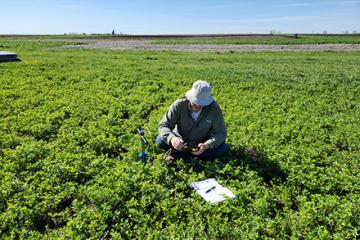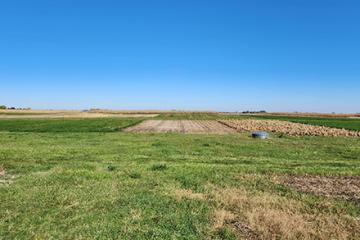USA
July 16, 2024

Technician Ross Isley collects data on soil water content in an alfalfa field. (Photo by Sabrina Ruis).
Farmers know that organic practices can bring a higher price in the marketplace. But how does organic farming affect their soil? ARS researchers are helping to answer that question, by using large, longitudinal data sets to tease apart the complex issues involved in decisions about how to farm.
One of the most notable requirements of organic farming is the prohibition on using herbicides and pesticides that are often key components of conventional agriculture. Without those herbicides, farmers in organic systems may turn to increased tillage to rid their soil of weeds. Yet the practice of tillage itself has come under increased scrutiny because of the way it disrupts the microbiome and structure that allows soil to support life. Could organic farming actually be worse than a conventional system for soil as a result of intensive tillage? Or does the use of other practices common to organic systems (cover crops/green manure, perennial crops, animal manure/compost, and extended crop rotations) offset any negative tillage effects? And how do increased tillage and other organic practices affect important properties of soil, like the ability to absorb and retain water? Without herbicides to kill weeds, will yields be lower?
Sabrina Ruis, a soil scientist at the National Laboratory for Agriculture and The Environment in Ames, IA, is leading the effort to compare organic and conventional operations to answer these and many other related questions. Her work builds on years of data collection by other scientists, going back over a decade.
“I stepped into this wonderful long-term systems experiment and data set on soil health indicators that had not been analyzed in detail yet,” Ruis explained, “The experiment compared a tilled conventional corn-soybean system with a tilled organic corn-soybean-oat/alfalfa-alfalfa system. The soil health data included data on soil biological properties, soil chemical properties, and some soil physical properties. When we start looking at these soil health indicators, we can see some benefits of the organic system, especially in terms of soil aggregation and the biological indicators of soil health.”
Ruis is also looking at several key outcomes that are of particular importance for agriculture, including:
- Yield levels
- Nutrient losses through tile drainage
- Overall soil health and
- Soil carbon levels

Two organic plots used in the research lie behind a water collection pit.(Photo by Sabrina Ruis).
Previous work on the same experiment by ARS scientist Sally Logsdon and her team showed the organic rotation used more water than the conventional rotation in spring and fall, which can alleviate runoff and ponding. The greater water use in the organic rotation was attributed to the small grain and alfalfa phases of the organic rotation as corn and soybean were not actively growing during those seasons.
One advantage of the organic systems is that greater biodiversity can improve the health of the soil and the crops that grow in it.
“Labile carbon sources feed the soil microbes,” said Ruis, “and that can improve cycling of nutrients in the system and some of the other soil health indicators including soil aggregation, which can aid in water infiltration, and may alleviate compaction.”
For farmers, Ruis said, the takeaway is that organic farming can improve soil health indicators and provide other environmental benefits.
“If I were a farmer looking at these data and I were not quite comfortable making the leap from conventional to completely organic, I would say, ‘maybe I can start small with a portion of my acreage to start the transition.’ You start with just manure, or you start with just the diversified system.” Doing so, Ruis said, can be part of making soil resilient and sustainable for future generations. She also noted that there are programs to assist farmers with the transition to organic agriculture.
Questions still remain, though, and Ruis is collaborating with others from ARS and partner institutions to further investigate the effects of organic systems.
“I am looking at carbon and nitrogen balances in the system, how much is coming in from the plants, how much we’re removing, in terms of biomass or grain, and how much is left in the soil,” she said. “We are also looking at soil health with depth, because a lot of data in the literature looks at just that surface 15-20 cm, so we need to dig deeper to determine if the organic systems are enhancing soil health indicators deeper in the soil profile than their conventional counterparts.” To date, Ruis has not measured the ability of the soil to absorb and retain water in this study, but she plans to do so in the near future, noting that the literature shows organic systems can improve soil’s ability to absorb and retain water.
In addition, she said, “We will be looking at economics as well, so we can put some numbers to the yields, and the inputs and outputs that a farmer would use.”
With so many different factors at play, Ruis is well-positioned to dig up even more insights for farmers who are considering organic agriculture.